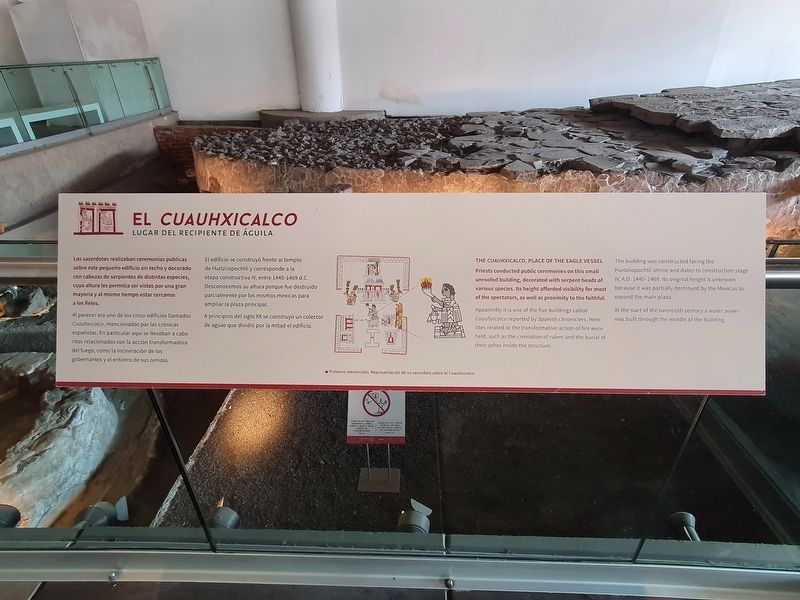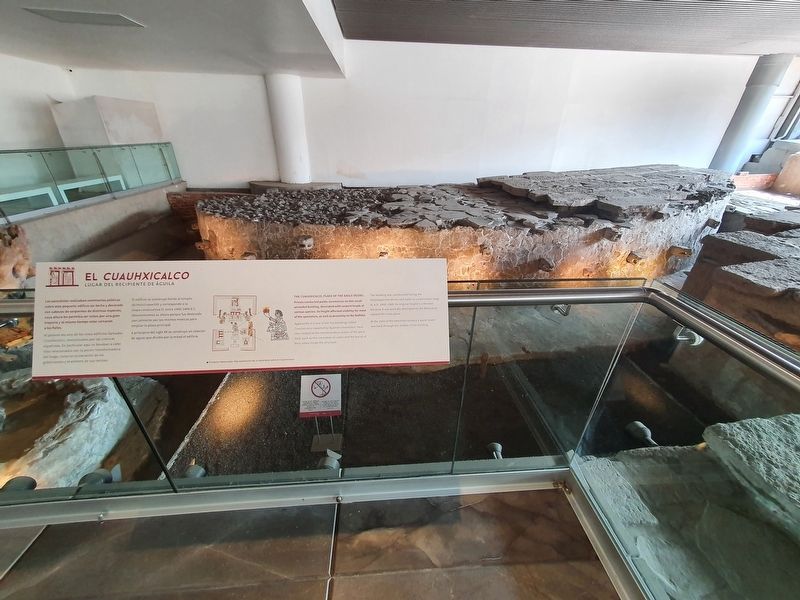Centro Histórico in Ciudad de México, Mexico — The Valley of Mexico (The Central Highlands)
The Cuauhxicalco, Place of the Eagle Vessel
Inscription.
Lugar del recipiente de águila
Los sacerdotes realizaban ceremonias públicas sobre este pequeño edificio sin techo y decorado con cabezas de serpientes de distintas especies, cuya altura les permitía ser vistos por una gran mayoría y al mismo tiempo estar cercanos a los fieles.
Al parecer era uno de los cinco edificios llamados Cuauhxicalco, mencionados por las crónicas españolas. En particular aquí se llevaban a cabo ritos relacionados con la acción transformadora del fuego, como la incineración de los gobernantes y el entierro de sus cenizas.
El edificio se construyó frente al templo de Huitzilopochtli y corresponde a la etapa constructiva IV, entre 1440-1469 d.C. Desconocemos su altura porque fue destruido parcialmente por los mismos mexicas para ampliar la plaza principal.
A principios del siglo XX se construyó un colector de aguas que dividió por la mitad el edificio.
Pie de dibujo:
Primeros memoriales. Rerpresentatcion de un sacerdote sobre el Cuauhxicalco
The Cuauhxicalco, Place of the Eagle Vessel
Priests conducted public ceremonies on this small unroofed building, decorated with serpent heads of various species. Its height afforded visibility for most of the spectators, as well as proximity to the faithful. Apparently it is one of the five buildings called Cuauhxicalco reported by Spanish chroniclers. Here rites related to the transformative action of fire were held, such as the cremation of rulers and the burial of their ashes inside the structure.
The building was constructed facing the Huitzilopochtli shrine and dates to construction stage IV, A.D. 1440-1469. Its original height is unknown because it was partially destroyed by the Mexicas to expand the main plaza.
At the start of the twentieth century a water sewer was built through the middle of the building.
Topics. This historical marker is listed in these topic lists: Anthropology & Archaeology • Churches & Religion • Native Americans.
Location. 19° 26.089′ N, 99° 7.921′ W. Marker is in Ciudad de México. It is in Centro Histórico. Marker is on Seminario just north of Plaza de la Constitución, on the right when traveling north. The marker is on the grounds of the Templo Mayor Museum. Touch for map. Marker is in this post office area: Ciudad de México 06000, Mexico. Touch for directions.
Other nearby markers. At least 8 other markers are within walking distance of this marker
. The Sacred Precinct of Mexico-Tenochtitlan (here, next to this marker); The Sacred Tree (here, next to this marker); What is the Templo Mayor made of? (a few steps from this marker); The Templo Mayor and its Seven Construction Stages (a few steps from this marker); Pedestrian Bridge over the Templo Mayor (a few steps from this marker); The City of Tenochtitlan (a few steps from this marker); The Mexica People (within shouting distance of this marker); Plaza in Front of the Templo Mayor (within shouting distance of this marker). Touch for a list and map of all markers in Ciudad de México.
Credits. This page was last revised on February 7, 2023. It was originally submitted on September 8, 2022, by J. Makali Bruton of Accra, Ghana. This page has been viewed 103 times since then and 10 times this year. Photos: 1, 2. submitted on September 8, 2022, by J. Makali Bruton of Accra, Ghana.

